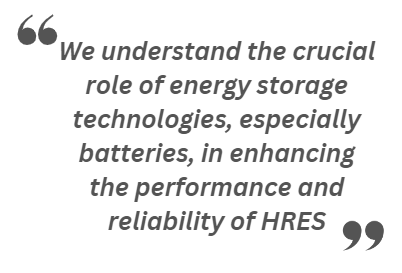At Tamaris Roofing, we are proud to offer Hybrid Renewable Energy Systems (HRES), a unique solution combining solar power panels and wind turbines into one efficient system. By integrating these two separate systems, we significantly reduce downtime and overcome the limitations of standalone systems.
This innovative capability is a first for a roofing company, allowing us to harness sustainable natural resources and generate power, day or night, rain or shine. Whether it’s sunny, windy, or stormy, we can install a system that maximises energy production and sustainability for your home or business.
Combining solar panels and wind turbines ensures a consistent energy supply, reducing downtime and mitigating the disadvantages of relying on a single energy source.
HRES maximises energy production by utilising both solar and wind resources, ensuring that power generation continues regardless of weather conditions—day or night, rain or shine.
HRES roofs harness sustainable natural resources, significantly reducing reliance on fossil fuels and lowering carbon footprints. This contributes to a greener, more sustainable future.
By generating your own renewable energy, you can reduce or even eliminate your electricity bills. Over time, this leads to substantial savings and can even provide a return on investment.
Our Hybrid Renewable Energy Systems (HRES) offer a viable, sustainable, and efficient solution for mitigating the impacts of climate change and securing a more sustainable energy future. By combining solar and wind energy, our hybrid systems optimise energy production, reliability, and efficiency.
These systems are designed to maximise the benefits of both solar panels and wind turbines, ensuring continuous energy generation regardless of weather conditions. This approach not only enhances energy reliability but also significantly reduces the carbon footprint, contributing to a greener planet.
Combining solar and wind energy into a hybrid renewable energy system can be done in various ways to optimise energy production, reliability, and efficiency.

The major harmful emissions from burning LPG are similar to those from other internal combustion engines: Carbon monoxide (CO) Hydrocarbons (HC) Nitrogen oxides (NOx). 1 kg of LPG produce 3 kg of CO 2 .
Learn more about the Hot Melt Code of Practice

The buildings and construction sector stands as the foremost contributor to greenhouse gas emissions, representing an overwhelming 37% of the total global emissions. Given its significant contribution to climate change, addressing emissions within our projects is paramount to achieving sustainability goals and mitigating the impacts of global warming.
The built environment, with the construction sector playing a pivotal role, presently accounts for approximately 40% of the UK’s carbon emissions. Moreover, estimates suggest that the construction sector contributes up to 11% of global carbon emissions. This underscores the significant impact of construction activities on carbon footprints, highlighting the urgent need for sustainable practices and innovations within the industry to mitigate climate change.
Self-Adhesive Roofing Felt requires no flames during installation, enhancing safety and simplifying the application process. It is manufactured from a polyester base with an SBS (Styrene Butadiene Styrene) bitumen coating.
The release film protects the underside of the sheet and can be easily removed during installation, in compliance with BS 8217: 2005, ‘Code of Practice for Reinforced Bitumen Membranes for Roofing.
The self-adhesive properties eliminate the need for gas torches, hot works, hot bitumen, and other messy sealants, making installations simpler and less time-consuming.
Single layer or multi-layer systems are ideal for roofing applications such as porches, garages, extensions, and dormer windows. They are also suitable for larger-scale projects due to their easy, no-fire installation.
Whether roller-applied, poured, or sprayed, the adhesives used to create warm roof insulated systems are flexible and feature high bond strengths. As a responsible and diligent roofing company, Tamaris Roofing is committed to ensuring the safest possible installation methods for our employees, clients, and the industry.
When a fully built-up system is utilised, primers, activators, torch-free membranes, and insulation adhesives can all be employed. Primers must be suitable for application in any season to ensure an adequate bond that resists wind uplift, with activators available to strengthen this bond.
Advanced self-adhesive technology is used in bitumen membranes for bonding to the substrate. The factory-applied adhesive is protected by a thin release film to prevent sticking inside the roll. During application, the installer uses the peel-back release film to unroll the membrane onto the surface.
The laps are welded using heat, and a visible bitumen bead from the welded laps indicates a secure and robust installation.

Lifetime emissions from the site should be net zero. Although these sites are generally considered to have a positive impact on emissions reduction because of the production of renewable electricity, there is still the need to ensure that lifetime emissions from the construction, operation and decommissioning of sites are minimised, by for example electrifying the construction and maintenance fleet or by offsetting embedded emissions from the production and construction of the site.
All ancillary buildings onsite should also aim to be net zero. Low carbon construction materials and practices should also minimise the carbon footprint of the development e.g. by local procurement and minimising transport of materials; also supporting the local economy and green growth and seeking to maximise social value benefits throughout the project lifetime in procurement, construction and operation processes. Solar developments should also contribute to the greening of the local economy through increasing green jobs, and green sector skills through upskilling their workforce for example, as these skills will be transferable for both large- and small-scale solar installations. This will also support the Essex Climate Action Commission recommendation to “make Essex a centre of innovation for emerging renewable technologies (e.g. small scale nuclear, & manufacturing of renewables products such as solar tiles)”.
For the full article visit The Essex Design Guide. Also visit Essex Climate Commission to learn more.